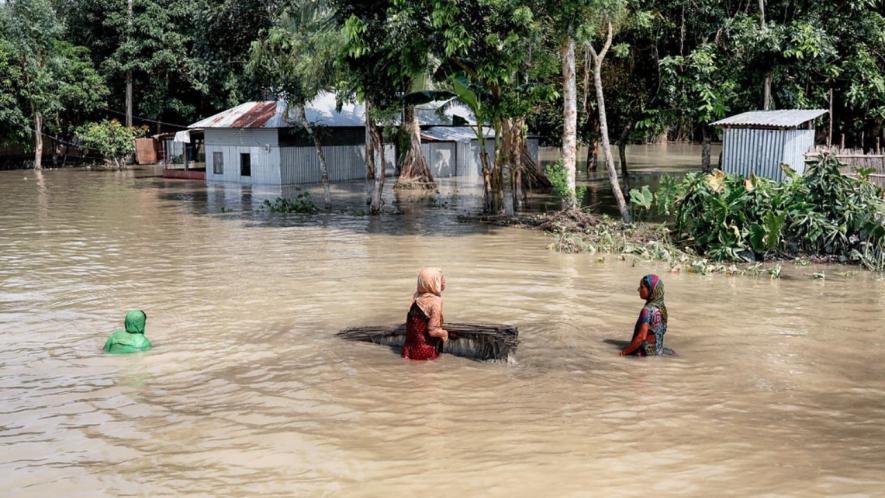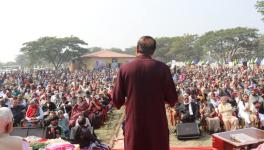Dam and Deluge: Decoding Tripura-Bangladesh Floods

Representational Image. Image Courtesy: Flickr
In the third week of August 2024, disturbing visuals of people — poor and helpless — relocating to relief camps from their houses submerged under water were seen on social media. With no regard for national boundaries, an unprecedented deluge had affected North Unkoti, Dhalai, Khowai, Gumti and South Tripura districts of Tripura in India, and Kumilla, Chattogram, Noakhali, Feni, Khagrachhari, Maulvibazar, Habiganj, Brahmanberia, Sylhet and Lakshmipur districts of Bangladesh.
A war of words ensued between the Indian and the Bangladeshi sides, with Bangladesh’s Nahid Islam, one of the anti-discrimination students’ movement leaders who is part of the recently-installed Interim Government, commenting that it is India who is responsible for the disaster wrecked upon more than 36 lakh people. The Dumbur Dam, situated in Tripura over the Gumti River that flows into Bangladesh, had released large amounts of water on August 21, after 31 years. Many flood-affected people accused that it was ‘India’s water’ that drowned them. India, by intentionally opening the sluice gates of the Dumbur dam in the middle of the night without informing the Bangladeshi authorities, was accused of unleashing water as a ‘weapon’ against their country.
The Indian authorities regarded these allegations to be factually incorrect. On August 22, the Ministry of External Affairs in a statement claimed that “the catchment areas of Gumti river that flows through India and Bangladesh have witnessed heaviest rains of this year over the last few days. The flood in Bangladesh is primarily due to waters from these large catchments downstream of the dam.”
This line of reasoning has been echoed in a report by the Bangladeshi news portal Prothom Alo. It quoted Sardar Uday Rayhan, an official of the flood security division of the Bangladesh Water Development Board, who said that the seven main rivers of North-Eastern and South-Eastern Bangladesh were already flowing above the danger level. The lunar cycle had caused high tide waters to rise above normal.
Additionally, the low pressure created on the sea had entered the land on August 18, and caused a severe landfall in Tripura and the hilly parts of South-Eastern Bangladesh. Reports suggest that on 19th August, Feni, Khagrachhari, Noakhali, Kumilla, Maulvibazar in Bangladesh and South Tripura in India had received unexpectedly high rainfall, which worsened the flood situation. However, some experts argued that India should have forewarned its neighbour about the dangerous flood situation prevailing upstream.
Empirical data suggests that it was the heavy rainfall caused by monsoon winds and the low pressure and not the opening of sluice gates of the Dumbur Dam which had prompted the disaster. The waters of the Dumbur lake flow into the Gumti River and pass on to Bangladesh. After flowing through large parts of Kumilla, Debidwar, Muradnagar, and Daudkandi, the waters move into the Meghna River system. The rivers Feni and Muhuri, which flooded large parts of South-Eastern Bangladesh, have no connections with the Gumti River and the Feni district is not situated in the Gumti River valley either. Heavy incessant rainfall in Feni and the discharge from the hills caused floods in Khagrachhari and Feni. In Chouddogram in Kumilla, the Dakatia River had overflowed. Due to the saturation of the canals and waterways in Noakhali, the flood waters did not get passages to be drained out. The pressures from the Brahmaputra River system only added to the problem.
Long-term climate trends also support India’s argument. Bangladesh is one of the world’s regions most vulnerable to natural hazards caused by anthropogenic climate change. The World Bank’s 2024 ‘Climate Risk Country Profile’ of Bangladesh stated that about 56% of the country’s population lives in areas most exposed to floods and other natural hazards. The World Bank’s ‘Country Climate and Development Report’ on Bangladesh published in October 2022 regarded climate change-induced flooding as “the most economically draining natural hazard” in the country.
According to the statistics presented by the World Bank’s Climate Change Knowledge Portal, the average annual occurrence of floods was 81 between 1980-2020, which amounted to 26.56% of the total number of natural hazards afflicting the country. Ahsan Uddin Ahmed’s 2006 report titled ‘Bangladesh Climate Change Impacts and Vulnerability: A Synthesis’, in its discussion of the country’s vulnerability to floods listed the following reasons for the occurrence of floods: “huge inflow of water from upstream catchment areas coinciding with heavy monsoon rainfall in the country, a low floodplain gradient, congested drainage channels, the major rivers converging inside Bangladesh, tides and storm surges in coastal areas, and polders that increase the intensity of floodwater outside protected areas.” The report further stated that floods of high intensity occur when the rate of discharge of the river is less than the rate of accumulation of water. These are often caused by inefficient water management infrastructures.
Despite objective facts hinting at a more complicated scenario, tendentious keyboard warriors from both India and Bangladesh got busy bashing each other on social media using reductionist (or untrue) statements. Bangladeshi YouTubers waged a concerted campaign to attack the Indian government. They complained that India has built dams on all 54 rivers draining into Bangladesh and is robbing their country of their fair share of water. Indians retaliated with crude humour about the plight of their neighbours struggling to sustain their lives. Vain invocations of God’s wrath were made in reference to the violence inflicted upon Hindu places of worship by supporters of Jamaat-i-Islami after Sheikh Hasina’s ouster from power in July.
India using water as a ‘weapon’ against Bangladesh is an allegation far from the truth. Only two of the dams built on rivers flowing into Bangladesh from India are large-scale irrigation barrages: the Farakka Barrage on Ganga/Padma and the Gajoldoba Barrage on Teesta. Since these barrages divert a lot of water into water channels towards India, they have been subjects of long-standing disputes between the two countries which will be discussed later in the essay. All the other dams are either hydel dams or check dams. None of these other dams divert river water or affect its flow significantly.
The Nagor, Tangon, Punorbhobha and Atrai rivers flow from Bangladesh’s Dinajpur district into West Bengal’s South Dinajpur and again into Bangladesh’s Rajshahi division. There are check dams present on Tangon, Punarbhaba and Atrai in Bangladesh’s Dinajpur. The rivers of North Bengal: Jaldhaka, Torsha, and Raidak are glacial rivers and their waters are not diverted. There is no diversion of the Brahmaputra River or the Barak River and its tributary Jatinga in Assam. From Mizoram, the Karnaphuli/Khawthlangtuipui River flows into Bangladesh, which only has a hydel dam at the Kaptai Lake in Bangladesh.
In Tripura, none of the North-flowing rivers — Manu, Dhalai, and Khowai — have any dams on them. The Muhuri River has a small check dam named Kalashi. The Gumti River harbours the much-discussed Dumbur Hydroelectric power plant, but there is no diversion here as well. 80% of the rainwater from the Meghalaya hills flows southwards into Sylhet and Mymensingh, forming and replenishing large natural lakes or Haors.
We understand that the current floods have been caused by a complex admixture of long-term and short-term processes shaping the region's riparian landscape. However, the anti-India sentiments harboured by a significant section of Bangladeshis regarding water-sharing cannot be dismissed as completely ludicrous. Their genesis must be traced back to political, economic, and ideological constructions of the past.
The idea that river waters should be ‘owned’ and ‘controlled’ for human needs goes back to the colonial period. Kuntala Lahiri-Dutt and Gopa Samanta, through a discussion of the works of the noted engineer Sir William Willcocks (who was also responsible for the construction of the Aswan Dam in Egypt), showed how the fluvial Bengal Delta was dependent upon ‘overflow irrigation’ by the rivers in the ancient and medieval times. The regime of private property, inaugurated in Bengal by the Permanent Settlement, made land a prized commodity (for maximising revenue demand) meant to be safeguarded from the erratic action of rivers. Later, embankments and irrigation facilities were built to control the river waters.
Similarly, Rohan D’Souza, in his study of the Odisha riparian delta, demonstrated that interests of colonial capital had transformed the delta from ‘flood-dependent’ to ‘flood vulnerable.’. An ecological regime based on the forceful control of flood waters and subsequent transformation of fluvial ecologies into land markets (through the reclamation of marshes and alluvial char lands, as has been argued by Debjani Bhattacharyya) was laid out by the British colonial state.
With the Partition in 1947, there was a major change in the ecological regime of the Bengal Delta. Most of the alluvial fertile lands of East Bengal went to (East) Pakistan, while the rivers which drained them flowed through India. In his study of (West) Pakistan, Daniel Haines has argued that river waters had become crucial elements of nation-building in the aftermath of the Partition. Most of the lands in undivided Punjab were dependent on irrigation from the rivers for cultivation. Since the Radcliffe Line had sliced rivers into halves between the two countries, issues of control over the waters got translated into issues of sovereignty. Rivers became ‘national’. Both countries tried working out arrangements to ensure an equitable sharing of river waters. The 1960 Indus River Water Treaty, though with its share of problems, was a success.
The situation in the Bengal Delta was more complicated. Joya Chatterji showed that Murshidabad, despite being a Muslim-majority district, was brought into India due to the Congress’ insistence to keep control over the Ganga waters. The Ganga moved southwards into its lower course from this district, and if the river went into Pakistan, the Congress feared that Pakistan might arm-twist India into submitting to an inequitable water-sharing arrangement. There were several border disputes over control of river waters and the islands formed on them in the 1950s and 1960s. India and (East) Pakistan shared 54 rivers, as mentioned earlier, and in almost all cases, the latter was the lower riparian. (East) Pakistani authorities were anxious that India would deprive them of their waters. Things came to a head when India commissioned the building of the irrigation barrage at Farakka in Murshidabad over the Ganga/Padma River.
The 2,240-meter-long Farakka barrage, by diverting 40,000 cusec waters from the Ganga River into the Bhagirathi, was intended to serve two main purposes for India — increasing the navigability of the moribund Hooghly River, which was endangered due to the Damodar Valley Corporation project, and create convenient rail and roadway connection between south and north West Bengal. The (East) Pakistani (and later the Bangladeshi) authorities vehemently opposed the project. They feared that the dry season flow of the Ganga would be significantly hampered.
Surprisingly, this concern had been echoed by Kapil Bhattacharya, a Superintendent Engineer of the West Bengal Irrigation Department, who, in his book titled Bangladesher Nod Nodi Porikolpona first published in 1954 and reprinted in 1959, had presented a serious critique of the Farakka barrage plan. He saw it as prompted by capitalist interests. Apart from severely affecting the agrarian ecosystem surrounding the Ganga/Padma in (East) Pakistan, the barrage, he argued, would cause devastating floods in Bihar and Malda, and the rapid siltation of the Hooghly River. He also warned that the fierce rivers of North Bengal (the likes of Kushi, Mahananda and Teesta) might bring down significant amounts of water and flood large parts of the region. Going forward with Sir Willcocks’ earlier suggestion of building a dam below the source of the Mathabhanga River in Nadia was the rational solution for Bhattacharya. Despite having noble intentions, his opposition to the project was not viewed kindly by the Indian authorities, and he was termed a Pakistani spy by a section of the Indian journalists.
After the barrage became operational in April 1975, a historic long march from Rajshahi to Chanpaibabganj in demand of decommissioning the project was led by the nonagenarian mass leader Maulana Abdul Hamid Khan Bhashani. He accused India of depriving Bangladesh of Padma waters. At the diplomatic level, the Bangladeshi government accused India of violating principles of mutual cooperation in water-sharing. Although India and Bangladesh signed the Ganga Water-sharing agreement in 1996 (which stated that both the countries would receive 35,000 cusec flow in alternate 10-day cycles between March and May), the woes of Bangladesh were far from being mitigated, mainly due to climate variability. Kapil Bhattacharya’s ominous predictions have been vindicated, and apart from Bangladeshi politicians, Indian leaders like Nitish Kumar have also called for the removal of the barrage.
The dispute regarding the Teesta River is more complicated, since Mamata Banerjee, the Chief Minister of West Bengal, has opposed the arrangement of reserving 42.5% of its waters for India and 37.5% for Bangladesh. According to Banerjee, this would lead to the drying up of approximately one lakh hectares of land in North Bengal, thereby seriously affecting agriculture. The claim is only partially true.
Apart from Teesta, the northern part of West Bengal is primarily drained by glacial rivers like Torsha and Jaldhaka which do not have any diversions. Also, the irrigation potential of Teesta has been seriously compromised due to the rapid accumulation of alluvial soil due to the Gajoldoba barrage, climate variability, and the alleged illegal extraction of sand from the river beds. There has been no significant effort on part of the West Bengal government to solve the problem, which in turn is already affecting thousands of farmers in the region. Meanwhile, the Chinese authorities have proposed to invest $1 billion to dredge the Teesta River and build embankments to form a single manageable channel. India is opposed to this, owing to fears of Chinese intrusion near the strategically important ‘Chicken neck’.
The controversy regarding the proposed Tipaimukh dam on the Barak River rests on anxieties regarding the future of the endangered Haors in Bangladesh. In recent years, Bangladeshi public opinion towards India has veritably turned sour after Bangladesh allowed the latter to draw 1.82 cusecs of water per second from the Feni River in 2019 to help the inhabitants of Sabroom in Tripura.
The colonial legacy of extending sovereign control over river waters, the fateful Partition of 1947, and the ill effects of anthropogenic climate change plague people of both countries today. When I am writing this piece in the comfort of my privileged dwelling, lakhs of people in Tripura and South-Eastern Bangladesh are fighting against their present predicament to secure an uncertain future. Rivers flow along the line of least resistance. They care little about national boundaries. Or about who is a Hindu or a Muslim. Vigorous attempts to demarcate ‘national’ rivers with little regard towards preserving the fluvial ecologies of the Bengal Delta will invariably cause ‘international’ hazards like what we are witnessing today. What now? I am no expert to suggest any remedy. I am a fool trying to stop a forest fire with a bucketful of water. I earnestly hope that I am not the only one.
I would like to extend my heartiest gratitude to my dear friend Srestha Majumder for her constant encouragement and valuable inputs during the process of writing this piece. Nahid Rahman sent me important resources which came in handy: many thanks to him too. In the age of rampant misinformation, illuminating Facebook posts by Alakes Guchhait have been godsent. Lastly, the brilliantly committed on-ground reportage of the flood situation by Ganashakti has been a source of great inspiration to me.
The writer is a post-graduate from the Department of History, University of Delhi. The views are personal. This article was first published in the Lokayata blog on August 30, 2024.
Get the latest reports & analysis with people's perspective on Protests, movements & deep analytical videos, discussions of the current affairs in your Telegram app. Subscribe to NewsClick's Telegram channel & get Real-Time updates on stories, as they get published on our website.























